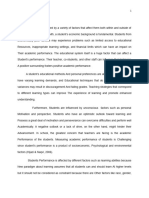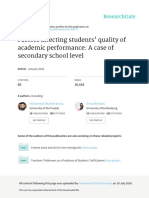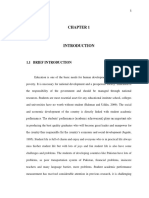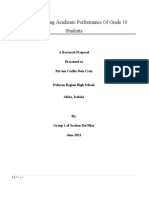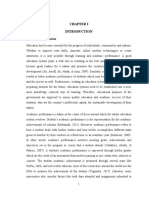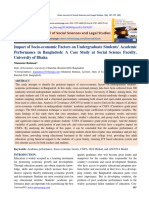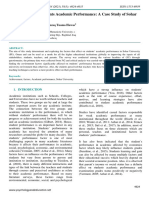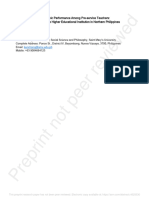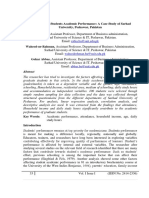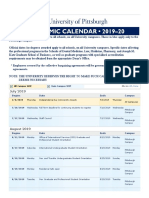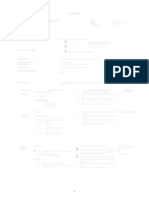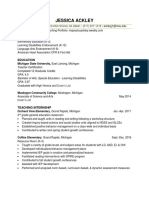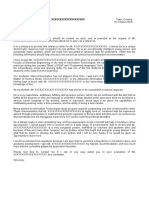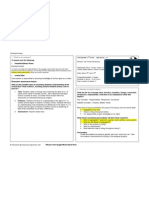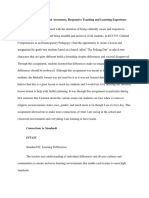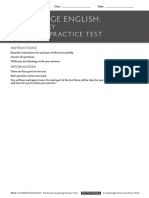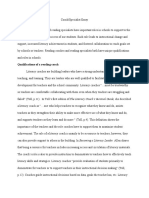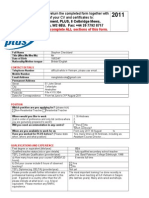CHAPTER ONE
1.0 INTRODUCTON
1.1 BACKGROUND OF THE STUDY
Academic performance as a concept has become a source of concern to
researchers, especially as the performance of the undergraduates is declining. The
Nigerian society vests great emphasis on education because it is believed to be the
only avenue for national development. This can only be achieved when
undergraduates in various citadel of learning get actively involved in different
academic activities which can enhance their academic performance. This is expected
to lead to the technological advancement of the nation. In spite of these laudable
values attached to academic performance, researchers (Ugoji 2008 and Egbule 2004)
have shown that students’ performance is declining. This could be because they are
confronted with so many school and nonschool related demands and responsibilities
(Ukpong, 2007).
The measurement of student performance can be useful in universities, based
on the notion that there are various factors that can contribute to the final grade
attained by the students. A true and thorough understanding of the complex learning
experience requires knowledge of various factors that determine the final grade of
students. While examining the influence of age, financial status and gender on
academic performance among undergraduates, Ebenuwa-Okoh (2010) used simple
random sampling to select sample size of 175 respondents. The study revealed that
gender, age and finance are not significant predictors of academic performance as
there were no significant difference in academic performance based on age, gender
and financial status. He then recommended that counseling centers should open to
1
�handle varying problems confronting student irrespective of age, financial status or
gender. Also see Bedard and Dhuey (2006), Crawford et al. (2007), Pellizzari et
al.(2011), Lao (1980), Kimball (1989), Wilberg and Lynn (1999), Stage and
Kloosterman (1995), and Afuwape and Oludipe (2008) for more details.
This problem seems to be a major one that requires urgent and serious attention since
students’ academic performance affects the quality of human resources within the
society, hence, the need for a project such as this arouses.
Regression models are powerful tools frequently used to predict a dependent
variable from a set of predictors. They are widely used in a number of different
contexts. An important problem is whether results of the regression analysis on the
sample can be extended to the population the sample has been chosen from. If this
happens, then we say that the model has a good fit and we refer to this question as a
goodness-of-fit analysis, performance analysis or model validation analysis for the
model (Hosmer and Lemeshow, 2000; D’Agostino et al., 1998; Harrell et al., 1996;
Stevens, 1996). Application of modelling techniques without subsequent performance
analysis of the obtained models can result in poorly fitting results that inaccurately
predict outcomes on new subjects.
We deal with how to measure the quality of the fit of a given model and how
to evaluate its performance in order to avoid poorly fitted models, i.e. models which
inadequately describe the above mentioned relationship in the population.
First we state an important preliminary assumption and the aim of our work,
and we introduce the concept of goodness-of-fit and the principle of optimism. Then
we illustrate a brief review of the diverse techniques of model validation. Next, we
define a number of properties for a model to be considered “good,” and a number of
2
�quantitative performance measures. Lastly, we describe a methodology for the
assessment of the performance of a given model.
Elementary Mathematics I (MTH101) is a compulsory first year course for all
students in the Faculty of Science in Benue State University Makurdi. The course is
an essential basis for many advance courses in Mathematics and other disciplines in
the sciences. Over the years, there have been recorded averagely poor performances in
this course, by students in most the departments in the faculty. Studies have shown
that poor performance in Algebra and Trigonometry is not restricted to Nigeria but to
Colleges and Universities of other countries, for example, United States of America
(Ferrini – Mundy and Graham 1991). Also, there are subjects for which poor
performance of students are noted and have been therefore subject of research studies.
Examples of such studies are found in (Edward et al.1996; Iduseri and Edokpa 2011;
Lauren et al. 2008; Mamta and Sandra 2014). Consequently, there must be some
inhibiting factors militating against students’ performance. The interest of this project
is therefore focused on identifying such factors among the students in the Faculty of
Sciences of Benue State University in order to provide basis for improvement
intervention strategy on course delivery.
1.2 STATEMENT OF THE PROBLEM
Success in the academic arena is an achievement that often requires students to
overcome many hurdles, some of which are more challenging than others. If academic
performance hinged on raw intelligence and work ethic alone, academic success
would be almost a given. However, other factors can contribute to a student's level of
success throughout all stages of education. The level of his parents' education, class
sizes, the type and location of school attended, type of admission, quality of teaching,
life in University, study habit, economic background of parents, references and
3
�textbook availability in a university, students placement by their first choice, peer
influence, study time etc. to which he is exposed are all issues that could stand in the
way of a student's success in the classroom. Developing an awareness of the factors
that could negatively impact academic success is one way to better prepare parents,
teachers and students to deal with them.
Socioeconomic Status: Students whose families are of low socioeconomic status
progress more slowly academically than their wealthier peers. Wealth and status are
an umbrella for many issues that affect performance, including suffering chronic
stress, having little to no homework help available at home and having obligations
around the house or at a part-time job that may curtail study time. Literacy and
development issues can begin to affect children before they are even of school age,
putting them at an immediate disadvantage.
Parents' Education: The amount and quality of homework and study assistance
available at home can impact a student's performance. However, the level of
education achieved by parents can also influence a student's ability to achieve by
affecting parental expectations. Parents are "expectancy socializers," according to
researchers at Wayne State University. If they set the bar of success high for their
children and systematically encourage them, their children are more likely to perform
well at school. And those expectations for success are connected to the amount of
education a parent has received.
Class Size: The students-per-teacher ratio of a school is a statistic that interests many
parents and is often used as a recruitment tool. But how much does class size really
matter when it comes to student performance? The Center for Public Education found
that smaller class sizes (18 students or fewer) had the greatest benefit for kindergarten
4
�and early elementary school students; those benefits, however, hinge on the quality of
the teachers. The largest achievement gains were observed in minority students and
those of low socioeconomic status, providing a concrete strategy to combat the
challenges faced by these populations. And the effects are lasting. Students who
learned in less-populated classrooms in elementary school scored higher on ninth
grade standardized tests than their peers.
Study Habits: The problems associated with study habits might have a major effect
on a student’s academic performances, it is believed that everyone has a different
study habit and it is important to find out the best personal way to study. Studying
with friends has a long way to go in student’s study habits, it has a positive influence
in which they discuss what have been read together but also has a negative effect in
which they might not read but discuss throughout the stipulated time for reading
which boils down to time wastage.
Reference and Textbook Availability: A very good and conducive library
environment encourages students study habit and might have positive impact of their
academic achievements but students reading in an unfavorable environment with
limited reference materials might find it difficult to study which might affect their
academic achievements.
Students with financial constraints might also find it difficult to perform excellently
well in their academics
1.3 AIMS AND OBJECTIVES
5
� The main purpose of the study is to examine the effects of those factors that affect
Student’s Performance in MTH 101 in Benue State University Specially, this study
seeks to examine:
1. The possible relationship of study habits and how it enhances good grades in
improving academic performance of students.
2. To determine some of the key factors affecting students academic
performance.
3. Proffer solution on how a student can acquire effective study habits to improve
academic performance especially in elementary mathematics.
1.4 DEFINITION OF BASIC TERMS
Logistic Regression Model
There are several studies on factors that inhibit students’ performance in courses at
the undergraduate level. Some of the factors identified are high school grades (Russel
and Julie2006) and (Edge and Friendberg 1984), belief and attitudes (Kloosterman
and Stage 1992) and (Kloosterman et al 1996), motivation (Lowis and Castley 2008)
and Socio-economic (Akanle 2007). The approach of studying these factors are based
on either Logistic regression method (Aromolaran et al. 2013), (Omar et al. 2002),
(Angela et al. 2013) and (Adejumo 2012) or Discriminant analysis (Blazenka &
Dijana 2009), (Erimafa et al. 2009), (Fagoyinbo et al. 2013) and (Humeral et al.
2015). Here we adopt the logistic regression approach because of its advantages.
6
�Logistic regression analysis extends the techniques of multiple regression to research
situations in which the outcome variable is categorical. Applications abound in the
fields of medicine (Sharareh et al. 2010), social sciences (Chuang 1997) and
education (Aromolaran et al. 2013).
Its salient feature is that there is a binary response of interest and the predictor
variables are used to model the probability of that response. Here the binary response
variable, Y, is:
Grades D – F, coded as 0; regarded as students at risk of being successful in MTH101
course and
Grades A – C, coded as 1; regarded as students not at risk of being successful in
MTH101 course.
The predictor variables are the factors being investigated, for possible influence on
the response variable.
To fit a binary logistic regression model, a set of regression coefficients that predict
the probability of the outcome of interest are estimated. The same logistic model can
be written in different ways.
Suppose that we have k independent observations y1…… yk, and that the i-th
observation can be treated as a realization of a random variable Yi.
We assume that Yi has a binomial distribution
Yi ~ B(ni, πi)
with binomial denominator ni and probability πi. With individual data ni = 1 for all i.
This defines the stochastic structure of the model.
Suppose further that the logit of the underlying probability πi is a linear function of
the predictors
logit(πi) = x'iβ,
7
�where xi is a vector of covariates and β is a vector of regression coefficients.
This defines the systematic structure of the model.
The model defined above is a generalized linear model with binomial response
and link logit. Note, incidentally, that it is more natural to consider the distribution of
the response Yi than the distribution of the implied error term Yi -µi
The regression coefficients β can be interpreted along the same lines as in
linear models, bearing in mind that the left-hand-side is a logit rather than a mean.
Thus, βj represents the change in the logit of the probability associated with a unit
change in the j-th predictor holding all other predictors constant. While expressing
results in the logit scale will be unfamiliar at first, it has the advantage that the model
is rather simple in this particular scale.
Exponentiating Equation the above equation, we find that the odds for the i-th unit
are
given by
𝜋𝑖
= exp{𝑥′𝑖𝛽}
1 − 𝜋𝑖
This expression defines a multiplicative model for the odds. For example, if
we were to change the j-th predictor by one unit while holding all other variables
constant, we would multiply the odds by exp{βj}. To see this point suppose the linear
predictor is x'iβ and we increase xj by one, to obtain x'iβ + βj. Exponentiating we get
exp{ x'iβ } times exp{βj}. Thus, the exponentiated coefficient exp{βj} represents an
odds ratio. Translating the results into multiplicative effects on the odds, or odds
ratios, is often helpful, because we can deal with a more familiar scale while retaining
a relatively simple model.
8
�The general linear logistic regression model is defined as:
𝑝(𝑥)
𝐿𝑜𝑔 ( ) = 𝛼 + 𝛽1𝑋1 + 𝛽2𝑋2 + ⋯ 𝛽𝑘𝑋𝑘
1 − 𝑝(𝑥)
Where Xi, i=1,……k are factors being investigated and
P(x)= P(Y=1/X=x)
1
= ∑ 𝑘
1+𝑒 𝑖=1 𝛽𝑖𝑋𝑖
Where the vector X=(x1,x2……,xk)
Hence the odd ratio is
𝑝(𝑥)
∏(𝑥) =
1 − 𝑝(𝑥)
9
� CHAPTER TWO
2.0 LITERATURE REVIEW
Academic performance is defined or regarded as participants’ examination
grades (grade point average at the end of a particular semester or programme). It
refers to the score attained by an examinee in an administered standardized test. It
could also be seen as the level of performance in a particular field of study. Higher
scores indicate better academic performance (Egbule 2004).
Khata, et al. (2011) conducted a study was to determine if parent educational
status influences the educational achievement in high school science. The study
utilized the student’s grade point average (GPA) for science during high school years
to measure achievement. The data for the study came from the National Assessment
of Educational Progress (NAEP) High School Transcript Study (HSTS) 2005. The
study compared the mathematics achievement to parent educational statuses and
10
�revealed that there were statistically significant differences in science GPA scores
between parent educational statuses; however, the effect size was small.
Adeyemo and Babajide (2012) examined the influence of social and economic
disadvantage on students’ academic achievement in senior secondary school physics.
One hundred and ten students were randomly selected across two randomly selected
senior secondary schools in Lagos state. From each of the selected schools, the
researchers selected fifty five physics students using the simple random sampling
technique. Based on result obtained there is no significant relationship between socio-
economic disadvantaged students and their academic achievement. Also there is no
significant relationship between parental influence and students’ academic
achievement in physics. Similarly, Yusuf (2012) investigated the influence of family
status on undergraduates’ academic performance in economics. Questionnaire was
administered to 300 randomly selected students from economics department of three
universities in Osun State. The study found that family size, parental education and
family socio-economic status has no significant impact on academic performance of
undergraduates in Economics.
Iqbal and Khan (2012) assessed the relationship between socio-economic
conditions of the parents and academic achievements of students at government
schools. A random sample of 69 students was selected from all the 16 secondary
schools for boys who had passed secondary examination from the board of
intermediate and secondary education. The findings of the study showed a significant
relationship between parental socioeconomic conditions and academic achievements
of the children in secondary examination. Udida, et al.(2012) examined the influence
of parental socio-economic background on the academic performance of students in
selected public secondary schools in Calabar municipal local government area of
11
�Cross River state. Multiple regression result revealed that parental socio-economic
background significantly influenced students’ academic performance, as students
whose parents had better jobs and higher levels of educational attainment and who
were exposed to more educational and cultural resources at home tended to perform
better than their counterparts without such opportunities.
Osuafor and Okonkwo (2013) sought to find out how family background of
students influences their academic achievement in senior secondary school Biology.
A survey design was adopted for the study. Five hundred and forty-six (546) senior
secondary two (SS2) biology students were drawn by simple random sampling from
14 schools within Awka, Nnewi and Onitsha education zones, in Anambra State.
Primary data were collected using questionnaire whereas secondary data were
obtained from students’ SS1 and SS2 school results. The results of the study revealed
that family structure, parents’ occupation and educational level, did not have
significant influence on students’ achievement in Biology. In a different study,
Alokan and Arijesuyo (2013) investigated the difference between the academic
performance of students from rural environment and students from urban
environment. The population for this study comprised all public secondary school
students in Ondo State. The sample consisted of 240 students from six randomly
selected schools. The result publicized that there is no significant difference in the
academic performance of students from the two different backgrounds.
Aromolaran, et al. (2013) in their empirical survey study conducted to
determine the socio-economic factors influencing students’ academic performance in
Yaba College of technology, collected data from six hundred (600) students across the
different departments using a 28 item structured questionnaire. The questionnaire was
administered using the quota sampling method, a non-probability sampling technique.
12
�The students’ academic performance was measured using variable GPA/CGPA
categorized into two - poor (GPA/CGPA between 0 and 2.49) and - good
(GPA/CGPA between 2.50 and 4.00). Four factors; mothers’ education level, living
togetherness of parents, student class and weekly income/allowance; were found to
influence students’ academic performance.
Chandra and Shaikh (2013) examined the relationship between socio-
economic status and academic achievement of 14 secondary school students of
Lucknow city of Uttar Pradesh, India. The sample of the study comprised of 614
students (358 males and 256 females) from classes IX and X. The results of the study
revealed the difference between high, average and low SES groups and their academic
achievement. Positive correlation was observed between socio-economic status and
academic achievement.
Musarat, et al. (2013) studied the ways in which student’s academic
achievements are effected by parental education and their socio-economic status.
Participants were 250 students taken from randomly selected departments. Research
findings were generalized to the university of Sargodha students. Data was collected
from participants through questionnaire containing three basic variables. Analysis of
data using descriptive statistics and ANOVA indicated that students belonging to
strong financial status perform better than those who face problems in finance.
Similarly, parental education boosts up their children’s performance.
Safdar, et al. (2013) investigated the relationship between parents’ socio-
economic status and children academic performance. The study was descriptive and
co-relational in nature. Seven hundred and twenty (720) students were sampled from
the selected districts. A positive significant relationship of total family income,
father’s job grade was found with the academic performance of the students. The
13
�results of this study, thus, showed that parents’ socio-economic status is an important
variable that influence their children academic performance.
Nnadi, et al.(2016) assessed the socio-economic determinants of gender-based
academic performances using field survey of Anambra State, Nigeria. Questionnaires
were used to gather data for analysis, while the binary logit estimation and ANOVA
techniques were used to test the hypothesis of the study. Findings revealed that there
is a significant difference between the performance of female and male students and
that number of hours of study is a very important determinant of academic
performance. Family size is also a significant factor in explaining academic
performance of students. Unexpectedly, parental educational status is not significant
in determining student’s academic performance. In addition, parental income is
significant in determining student’s academic performance and parent’s occupations
are not statistically significant.
According to the proponents of this theory, these factors are parental level of
education, parental involvement in children education, income of parent and financial
and material support given to the children by the parent. This theory has its own
shortcomings, among which is that the theory assumes that the interrelationships
within a system have to be recognized and understood by all people involved. The
theory also requires a shared vision so that all people in the school have an idea of
what they are to accomplish (Mweti, 2013).
Student academic achievement measurement has received considerable
attention in previous research, it is challenging aspects of academic literature, and
science student achievement are affected due to social, psychological, economic,
environmental and personal variables. These variables strongly influence on the
student academic achievement but these variables vary from person to person and
14
�country to country. Indeed, student academic achievement can be influenced by some
many variables these variables may be termed as student variables, family variables,
school variables and peer variables (Crosnoe, Johnson and Elder, 2004).
A large number of variables may significantly affect the student academic
achievement in university. For study purpose, we take Grade Point Average (GPA) of
students to measure academic achievement. This idea supported by (Hijaz and Naqvi,
2006) stated that GPA in University is commonly used indicator of student academic
achievement.
CHAPTER THREE
3.0 METHODOLOGY
This study is restricted MTH 101. This project which is a survey project will
make use of primary data collected with the aid of well-structured questionnaire. A
sample of students across faculty of science Benue state university, Makurdi will be
drawn from the department of Mathematics, Statistics and Computer Science,
Chemistry, Physics and Biological sciences respectively.
The questionnaire was chosen because it saves time and it can reach a large
number of students who are able to read and write independently (Orodho 2004).
According to Nkapa, (1997) a questionnaire is a carefully designed instrument for
15
�collecting data in accordance with the specification of the research questions. One
questionnaire which has three sections will be used to solicit data from students and
determinants of academic performance.
The data will be analyzed using statistical package for social sciences (SPSS).
A stepwise Logistic Regression method will be performed. The parameters will be
obtained by maximum likelihood method. The Neglerke R2, Chi – Square Test,
Hosmer- Lemeshow test and Percentage Accuracy in Classification (P.A.C) will be
used to assess the model fit. The wald statistic, likelihood ratio test and odds ratio
with 95% Confidence Interval (C.I) will be used to assess the significance of the
individual coefficient. Discriminant analysis will be also performed on the data. Here
the students falling respectively under the codes 0 and 1 of the independent variable
will form the two groups for the Discriminant analysis. A Discriminant analysis will
be performed primarily as a confirmatory analysis. This is because of the advantages
(Joseph et al. 2010) of the logistic regression over the Discriminant analysis.
These are:
i. Logistic regression does not require any specific assumption on the
distributional form of the independent variable.
ii. Heteroscadacity does not come to play as it does in Discriminant analysis and
iii. Discriminant analysis relies strictly on meeting the assumptions of
multivariate normality and equal variance-covariance matrices across groups
– assumptions that are not met in many situations. iv. Logistic regression is
much more robust when these assumptions are not met.
3.1 MODEL SPECIFICATIONS
16
�The variables and measurements
The variables are measured as follows;
The predictor variables(X1,……X7) consider: age of student, parents’
educational background, securing first choice of department, availability of textbooks
and references, environmental factor, study habit, place of residence before joining
university, peer influence, study time outside class, amount of money received from
family, arranging study time and good life later on.
X1: The dependent variable of this study is “academic achievement” which has two
binary outcomes if a student is not ok status (GPA less than 1.5) coded as 0 and if a
student ok status (GPA greater than 1.5) coded as 1.
X2: This is measured by monthly earning of the family head (it is expressed in ten
thousands). We choose this approach of rescaling instead of logging the values
because we used the estimated coefficients alongside the actual values of the variable
to calculate the probability of having high academic performance.
X3: PS = 1 if the student’s access to power supply is rated good (i.e. 3 hours and
above per day after school hour) and PS = 0 if the student’s access to power supply is
rated poor (i.e. between 0 and 2 hours).
X4: FS = 1 if the student from a large family (i.e. 7 persons and above) and FS = 0 if
the student is from a small family (i.e. less than 7 persons).
X5: RA = 1 if the student resides in the urban area and 0 if otherwise (Residential area
doesn’t necessarily mean where the school is located but where the student resides).
X6: PEA = 1 if the student’s parents are educated (i.e. secondary school and beyond)
and PEA = 0 if the student’s parents are not educated (i.e. below secondary school
level).
17
�X7: NHS = 1 if the number of hours the student studies is rate good (i.e. 2 hours and
above daily) and NHS = 0 if the number of hours the student studies is rate poor (i.e.
between 0 and 1 hour daily).
U = the stochastic error term which captures other intrinsic or random behaviour that
affect AP.
3.2 THE DATA
The data used will be derived from the questionnaire administered to students
using appropriate numerical codes. The grade of the students in MTH101 course,
which is the binary dependent variable, is coded as mentioned earlier. The
questionnaire covers largely the independent variables that will be investigated.
The choice of response to a question could be categorical, multiple choice, or
alternative choice answers provided on a likert scale.
The coding for the likert scale is done as follows:
Strongly agree is coded 4, agree 3, disagree 2, strongly disagree 1 and undecided 0.
All other types of choice of response were coded in a serial sequence. The coded form
of the response to the questionnaire by the students in the study constitutes the data
for analysis.
Data entry and cleaning will be carried out using statistical software package for
social science SPSS version 22.0 for the analysis. Descriptive statistics analysis will
be used to show the frequency distribution by using tables and charts where
necessary.
18
�Binary logistic regression model will be used in order to assess and identify the
influence of variables on student academic achievement.
The following questions will be reflected in the questionnaire
1. What is your age?
a) 18 or younger b) 19 – 20 c) 21 - 22 d) 23 - 25 e) 26 – 29 f) 30 or older
2. What is your gender?
a) Female
b) Male 3.
Place of residence?
a) Hostel
b) Off campus
4. What is your Jamb Score?
a) 180 to 199
b) 200 to 250
c) 250 and above
5. What is your O’level (i.e either WAEC or NECO or NABTEB) grade in
Mathematics?
a) A
b) B
19
�c) C
d) D
e) E
6. Career choice?
a) Imposed by Parents/School
b) Chosen by me
7. What is your GPA in 100 level?
a) Below 1.5
b) 1.5 – 1.9
c) 2.0 – 2.4
d) 2.5 – 2.9
e) 3.0 – 3.4
f) 3.5 – 5.0
3.3 PARENTAL BACKGROUND
8. What is your Parents education status?
1) Educated above secondary school
2) Educated below secondary school
3) Not educated
9. What is your parent’s financial status?
20
�a) Rich
b) Average
c) Poor
10. Home background?
a) Parents divorced
b) Parents apart
c) Parents deceased (either or both)
d) Parents living together
3.4 PARENT’S MOTIVATION
11. .During your Primary/Secondary School days, what is your parent’s level of
interest in what you have learnt in school?
a) Very interested
b) Interested
c) Not interested
12. After your school hours when you were in Primary/Secondary school, how
encouraging were your parents?
a) The organize extra lessons for me and the compel me to have reading hours every
day
b) They organize extra lessons for me
21
�c) The compel me to have reading hours every day
To What extent do you agree or disagree with the following statements in questions
13 - 23?
Question questions Strongly agree disagree Strongly undecided
number agree disagree
13 The
lighting and
ventilation
of the MAT
101
classrooms
during
lectures are
sufficient
14 The lecture
hall is
always over
populated
during
MAT 101
classes
22
�Course Delivery
15 The time
dedicated to
each topic
within the
course (MAT
101) is
sufficient and
meets the
requirements
of the syllabus
16 The lecturer
doesn’t miss
lectures and he
comes to class
early
17 The lecturer
makes good
use of the
examples
chosen
18 The lecturer is
able to
motivate the
23
� class
19 The lecturer is
able to awaken
the interest of
the students
for the Course
20 The lecturer
creates a
friendly
atmosphere
which
encourages
Participation
21 The lecturer
recommends
textbooks for
reading
22 The
recommended
reading list is
useful for
understanding
the Course
24
�23 The lecturer is
willing at all
times to deal
with students’
queries
Students Attitude related to the course
24. How challenging was this MTH 101 class for you?
a) Difficult
b) Somewhat challenging
c) Not very challenging
d) Easy
25. How will your level of success in this class affect your academic, career or
personal goals?
a) It definitely will not affect my goals at all
b) It probably will not affect my goals
c) It probably will affect my goals
d) It definitely will affect my goals
26. How has taking this course (MTH 101) affected your interest in Mathematics in
general?
a) As a result of this course, I am now less interested in Mathematics in general
25
�b) Taking this course has not affected my interest in Mathematics in general
c) As a result of this course, I am now more interested in Mathematics in general
27. Success in this course ( MTH 101) mainly requires
a) Memorizing facts, methods, and/or equations
b) Analyzing theories, concepts, or ideas
c) Synthesizing new information or ideas
d) Making judgments about the value of ideas
e) Applying learned ideas in practical situation
f) Offering my opinion, expressing my feelings or belief
3.6 STUDENT’S ATTITUDE RELATED TO THE SCHOOL
28. Why did you come to Benue state university?
a) Social or physical environment of Flagstaff
b) Social or physical environment on campus
c) Reputation of academic programs
d) Convenience
e) Financial incentive ( relative low cost of tuition, scholarship, etc)
f) Other
29. How satisfied are you with your overall experience at Benue state University?
a) Very dissatisfied
26
�b) Slightly dissatisfied
c) Generally satisfied
d) Very satisfied.
3.7 STUDENT MOTIVATION
30. How do responsibilities outside of school affect your success at school?
a) They don’t ever affect my success at school
b) They occasionally affect my success at school
c) The often affect my success at school
d) They always affect my success at school
27
